Turbosteen
I was born at a young age
- Joined
- Sep 4, 2008
- Location
- The Netherlands, Europe
This article is a work in progress, if you have additional info please say so!
Pictures will be resized etc. Lots of information is from Vadis and needs some retyping...
The B204GT/FT:
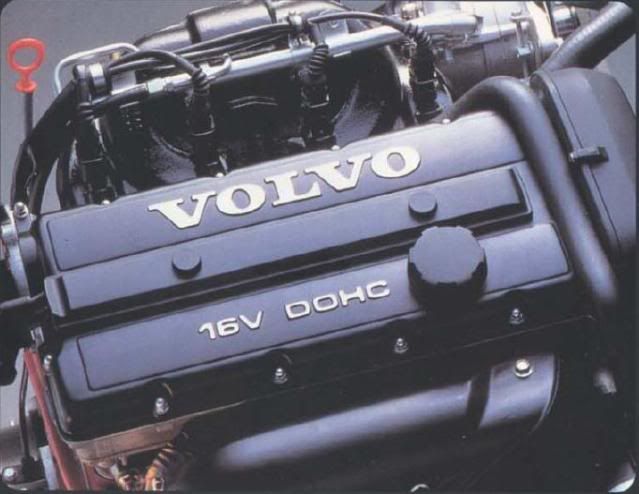
These engines were designed for a few European countries where the 2.0L displacement had an advantage for roadtax. These engines were available in Belgium, France, Italy [and Portugal, Spain and...?]
Overview picture:
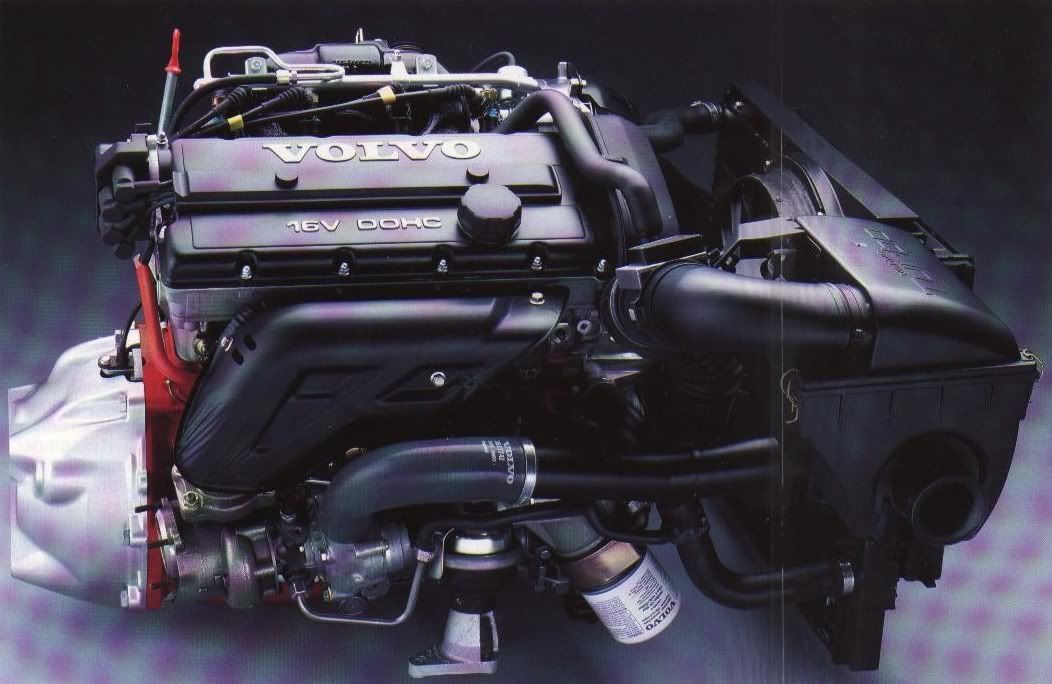
You can see a few things that are different:
- AMM (012). Also the plastic piping from airbox to AMM has a bigger radius
- Different intake and exhaust manifold
- Engine mount is also used for oil filter location
- Garrett T3 with internal CBV
History:
Here you see a press-release that never got to the press
It shows the basic info on the engine, but a preliminary amount of bhp and torque.
1
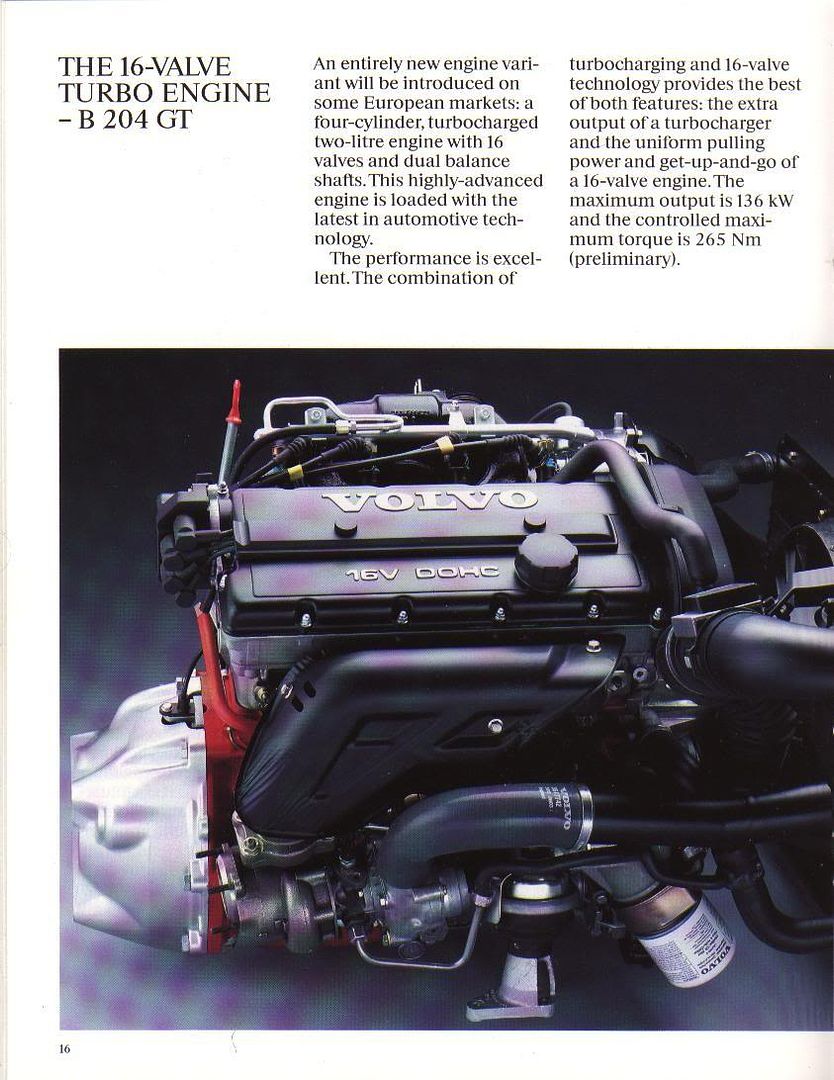
2

3
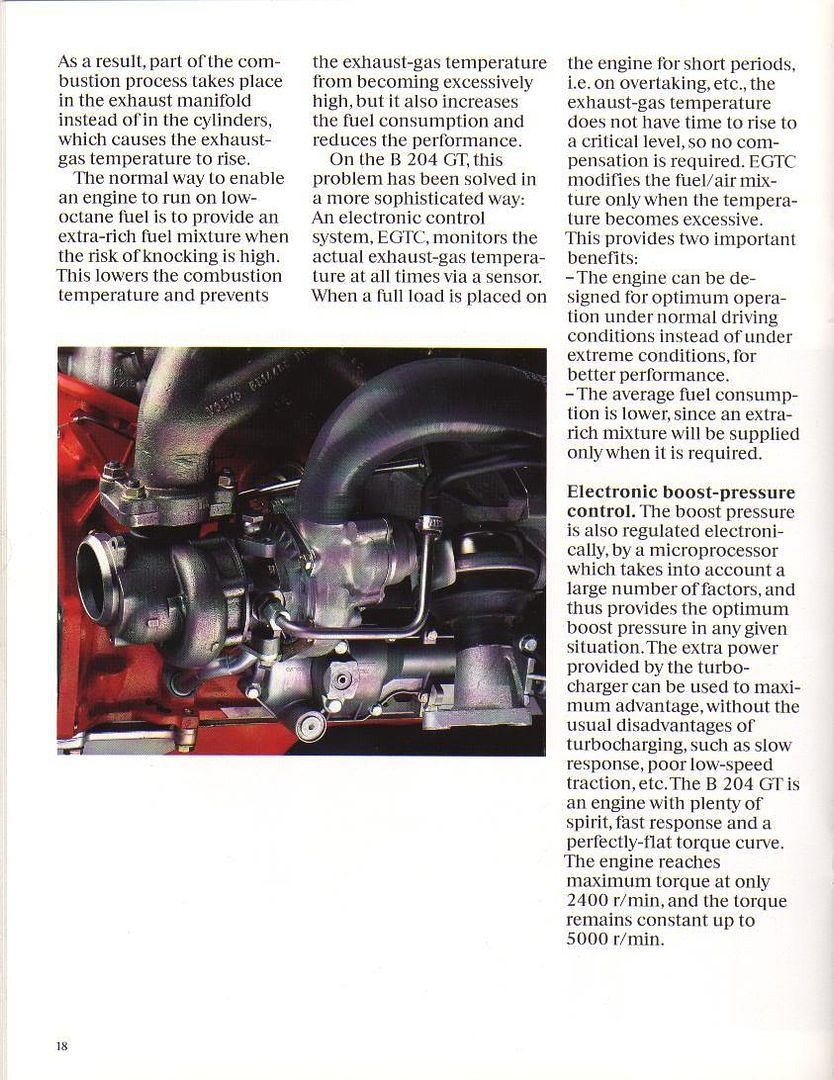
4

The B204GT was produced in 1989 and 1990 for the 740 and 780(as well?)
The B204FT was produced for the 960 up to 1994
The engine:
Basic info

Engines B204 FT/GT are two four cylinder 16-valve turbocharged engines of 2.0 liters cylinder capacity.
There is no difference in appearance between the two engines.
The difference between the FT and GT engines is that the GT does not have a three-way catalytic converter and has a lead resistant heated oxygen sensor (HO2S) so that it can be run on regular gasoline.
They were only produced with the M46. So no automatic or M90 (didn't exist up to '95)
Performance
B204GT:
- 200bhp @ 5300 rpm
- 290Nm (214 lbft) @ 2950 rpm
- acceleration 0-100 km/h (0-62 mph) = 7,9 seconds (740)
- top speed 215 km/h (136 mph)

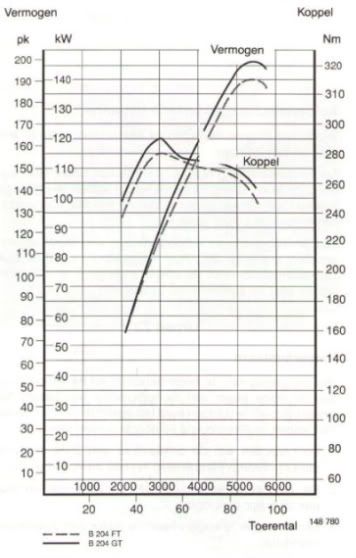
B204GT
B204FT:
- 190bhp @ 5300 rpm
- 280Nm (207 lbft) @ 2950 rpm
- acceleration 0-100 km/h (0-62mph) (in 960) = ????? seconds
- top speed ???
See the right graph above
CR = 8,2:1
Weight (with TC) = +/- 165kg
Valves
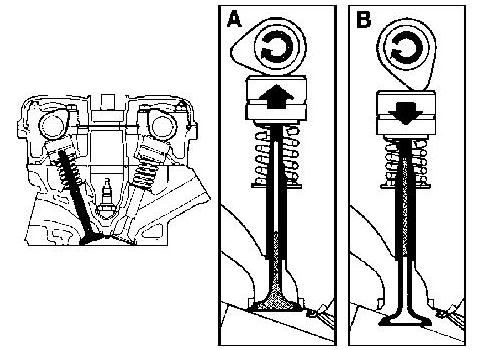
The cylinder head is built in the same way as Volvos other 16 valve engines the exception being certain differences in the camshafts and valves.
The camshafts have modified cam profiles with lower lift height and faster opening/closing. The valvesprings are slightly stiffer in order to follow the cam profiles.
The new cam shaft profiles give a high low rev torque combined with free revving.
The valves have the same dimensions as the B 204 E, but the exhaust valves are sodium filled for better cooling.
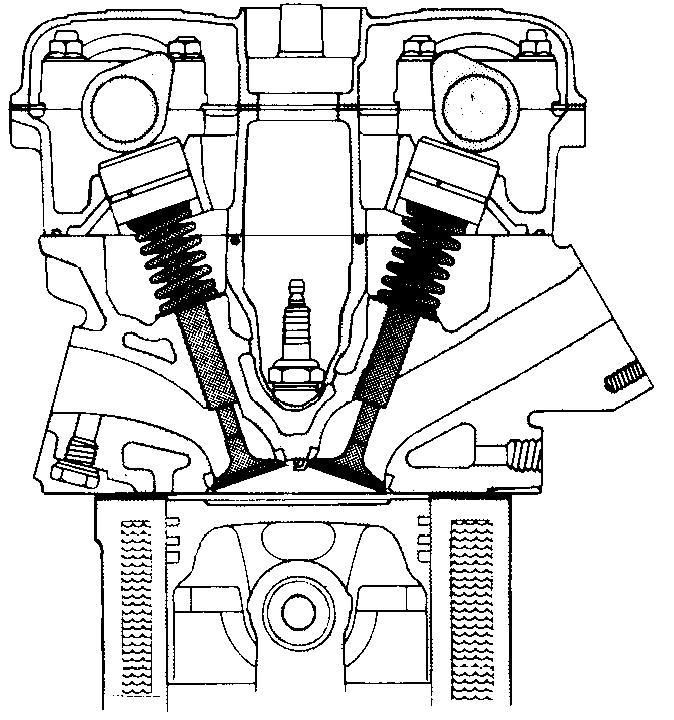
The valves are operated by twin overhead camshafts through hydraulic tappets. The oil-filled tappets are self-adjusting.
The valve guides are inclined at an angle of 19? to the vertical.
Valve springs are 26.5mm in diameter
LengthAAAALoad (N)
46.6AAAAAA0
37.0AAAAAA330-370
29.5AAAAAA665-735
Inlet valve = 32.50 mm
Exhaust valve = 29.50 mm
Camshafts
The B204GT and B204FT are fitted with the FI (inlet) and FA (exhaust) camshafts.
Max. lift FI: 6.81mm (valves to open @ 12.9? after top dead centre)
Max. lift FA: 7.45mm (valves to open @ 31.2? before bottom dead centre
Combustion chamber
The 'pent-roof' combustion chamber features squish zones which force the fuel/air mixture towards the centre of the chamber as the piston approaches top dead centre (TDC) on the compression stroke - a feature which promotes excellent mixing as the fuel approaches the spark plug. The resultant short combustion path promotes rapid combustion, reducing the risk of self-ignition (or knock) and enabling a high compression ratio to be used. This, in turn, yields high performance at low fuel consumption.
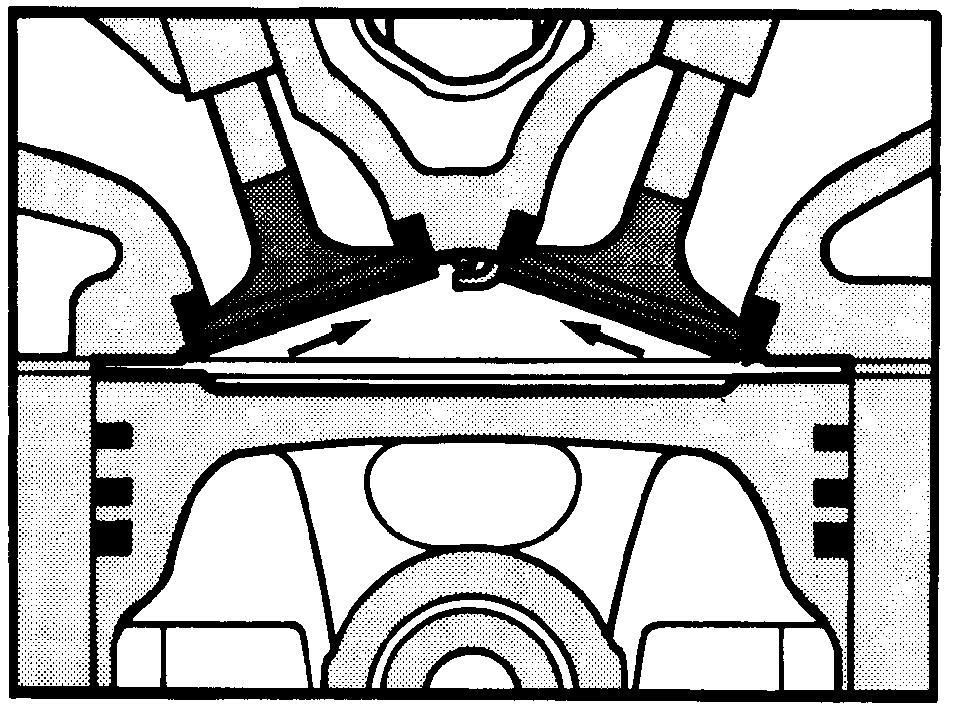
Turbocharger and exhaust manifold
The exhaust manifold together with the turbo gives the advantage that a larger amount of the exhaust motion and heat energies can be used to drive the turbine and the compressor.
The exhaust manifold is designed to give maximum emission speed and equal exhaust back pressure in all cylinders which means that the exhaust energy can be used in a more effective way.
The turbocharger (TC) has a integral by-pass valve which damps the pressure rises which occur as a result of the throttle shutting quickly, which can otherwise disturb the mass air flow (MAF) sensor and cause problems with driveability.
The more air that is carried to the engine the more fuel that be burned and thus the engine gives better performance.
The stock turbocharger is a Garrett T3
Hot side: .48AR
Cold side: .42 AR (55 trim wheel) with internal CBV
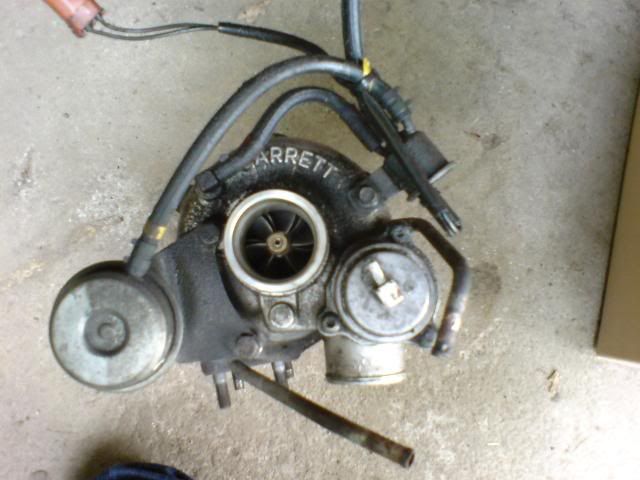

Oil
To satisfy the high turbo engine specifications, due to the high load and temperature, the following changes have been made compared to the other 16 valve engines.
1.The oil pump capacity has been increased by 20% by a wider pump wheel and a modified profile.
2.The relief valve has a stiffer spring and opens at 5 bar pressure.
3.The engine is equipped with piston cooling openings to cool the pistons.
4.The oil cooler ensures that the oil does become overheated with high loading.

Fuel System
TCU
The B204FT/GT engine is equipped with an electronically controlled turbocharger (TC) control system to give optimum boost pressure and thus engine power under all varying circumstances.
By varying the boost pressure electronically, the turbocharger (TC) gives full power from 2300 (I think this is incorrect, more like 3500) rpm which in turn gives high torque through the whole engine speed range.
To provide maximum power with good bottom end torque, fast response and low fuel consumption, the B 204FT engine is equipped with a control system which is regulated by a TCU (Turbo Control Unit).
The control module controls the turbocharger (TC) boost pressure, electric cooling fans and climate control AC compressor.
-1. Boost pressure control (BPC) valve.
-2. Throttle position (TP) sensor.
-3. Pressure regulator.
-4. Turbocharger (TC) control valve.
-5. Manifold absolute pressure (MAP) sensor.
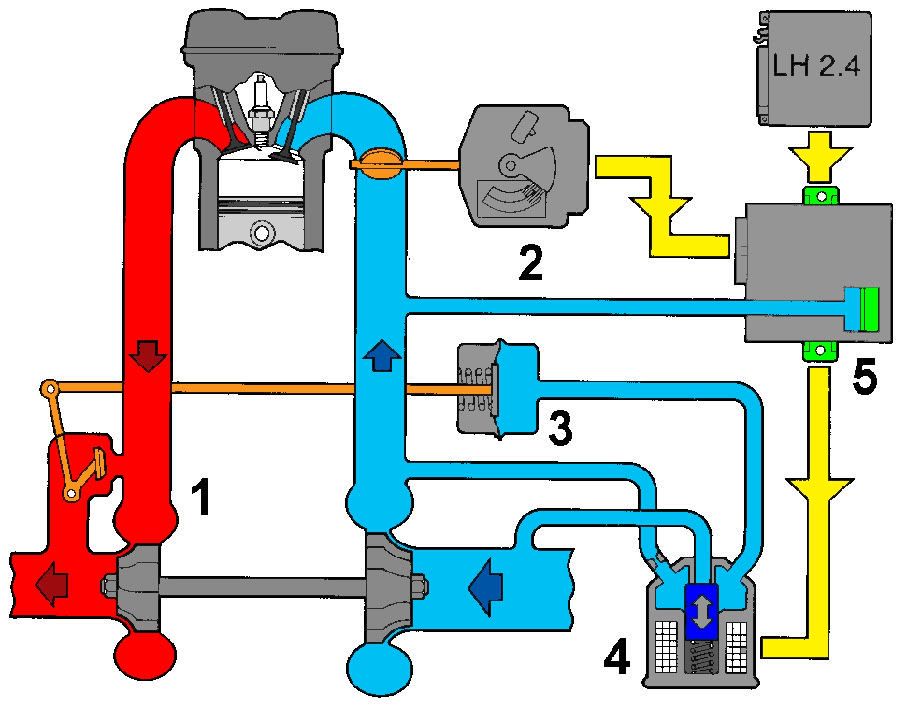
The control module receives information about the:
-Current turbocharger (TC) boost pressure from a manifold absolute pressure (MAP) sensor mounted in the control module.
-Engine speed (RPM) signal from fuel injection system control module.
-Information on the engine coolant temperature (ECT) from the temperature sensor mounted in the radiator.
-Throttle opening angle from throttle position (TP) sensor.
-Knock signal from the ignition system control module.
-Signal from speedometer.
-Signal from air conditioning (A/C) system pressure switches.
The control module carries out:
-Grounds the turbocharger (TC) control valve to control boost pressure.
-Lowers the boost pressure after maximum ignition retardation at ignition knock.
-Controls engine cooling fan (FC).
-Sends a signal to the LH-control module about idle air trim when the engine cooling fan (FC) runs at high-speed when the engine is idling.
-Disconnects the air conditioning (A/C) compressor when there is a high load on the engine.
-Is connected to the onboard diagnostic system and sends a signal if a fault occurs in the functions.
-Goes into an emergency program if certain signals are faulty or missing. The signals are given a programmed value so that the car can be driven to the workshop at a low speed.
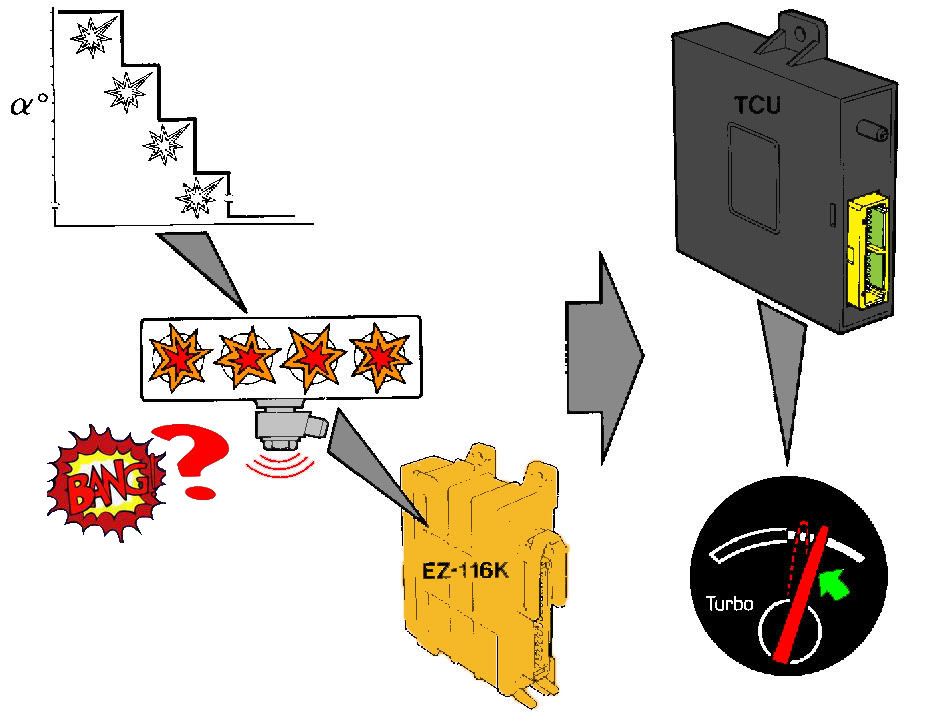
If ignition knock should occur the ignition is retarded individually for each cylinder until the knocking stops.
If the engine continues to knock despite the ignition being maximally retarded on each cylinder, the ignition system control module sends a signal to the turbocharger (TC) control module which then lowers boost pressure in stages.
The value of the boost pressure being lowered depends on when the knock occurs. This still gives lower fuel consumption than the previous system, when the fuel enrichment was corrected when the ignition was retarded maximally.
The turbocharger (TC) control valve is a three way solenoid valve which is used to control the turbocharger (TC) boost pressure exactly and so eliminate “turbo lag”.
When the solenoid valve is not operating the terminal to the turbocharger (TC) intake side is closed while the terminals between the turbocharger (TC) pressure side and pressure regulator are open. Only the turbocharger (TC) boost pressure affects the pressure regulator which then functions as a normal mechanical system for boost pressure control, which gives a relatively low boost pressure, maximum 40 kPa.
The turbocharger (TC) control system control module receives the signal from the throttle position (TP) sensor, engine speed (RPM) signal from LH 2.4–control module and determines a desired value for the turbocharger (TC) boost pressure. This desired value is changed to a control signal to the turbocharger (TC) control valve which opens. The terminals to the turbocharger (TC) intake side are connected to the turbocharger (TC) pressure side and pressure regulator for a limited time, which gives a reference pressure to the pressure regulator.
The control signal gives a fast pulsing square wave signal with a frequency of 32 Hz. The solenoid valve opens and shuts once per period. This gives a mixture of atmospheric pressure and boost pressure in the pressure regulator, which because of its sluggishness will assume a position which is proportional to the solenoid valve opening and closing times.
The control pressure depends on the relationship between the time that the valve is open or closed during a period.
Because the control pressure is a mixture of turbocharger (TC) boost pressure and atmospheric pressure the boost pressure can increase to a value that exceeds the value that the pressure regulator would usually regulate. Maximum turbocharger (TC) boost pressure is 80 kPa above atmospheric pressure. A high boost pressure is retained even at fast throttle opening despite low engine speed (RPM), which gives fast response and eliminates “turbo lag”.
TCU unit:

Close-up:
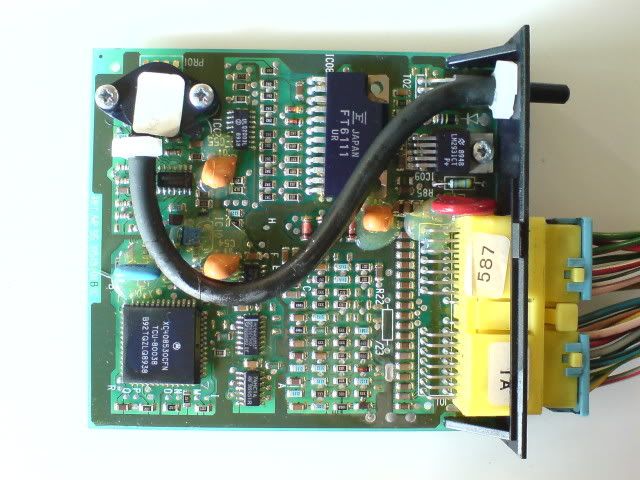
EGTC
To avoid excessively high exhaust gas temperatures and reduce fuel consumption a special temperature sensor called an EGTC (Exhaust Gas Temperature Controller) is used. The EGTC sensor consists of a thermo element mounted in the exhaust manifold in front of the turbocharger (TC). It senses the exhaust temperature and generates a signal which is amplified in an electronic circuit mounted on the reverse of the engine. The amplified temperature signal is sent further to the fuel injection system control module, which gradually extends the injection period exhaust when the temperature reaches a critical level (approximately 950?C).
This contributes to a lower combustion temperature which in turn reduces the exhaust gas temperature, after which the increased fuel supply stops when the exhaust gas temperature has reached a normal level.
High exhaust gas temperatures occur for example at high power takeup over a long period of time, when driving in a hot climate or when driving with low octane fuel.
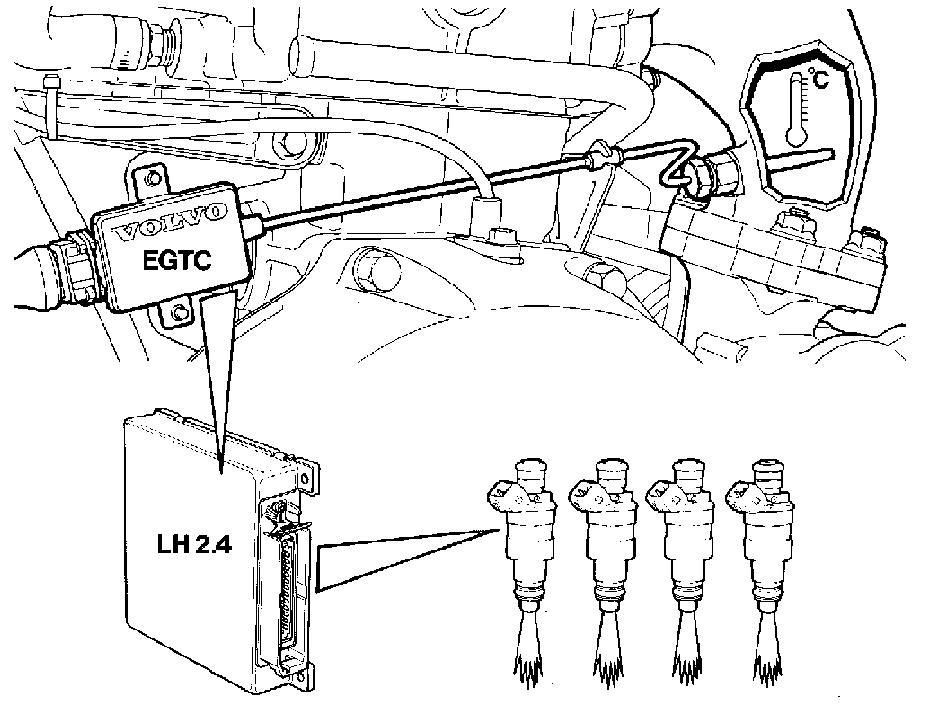

Inside the exhaust manifold
Mechanical:
The B204FT/GT engine has forged pistons, combined with the normal connection rods (13mm).
The pistons have valve reliefs cut in to them.
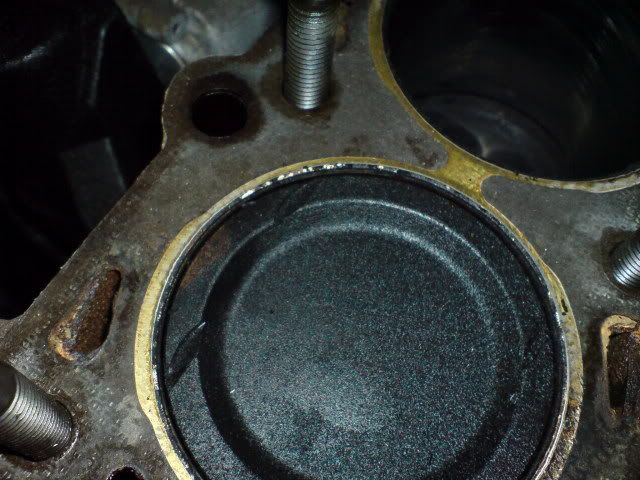
The engines are also equipped with a windage tray and block reinforcements (N/A 16V has the reinforcement as well, different p/n), see picture:
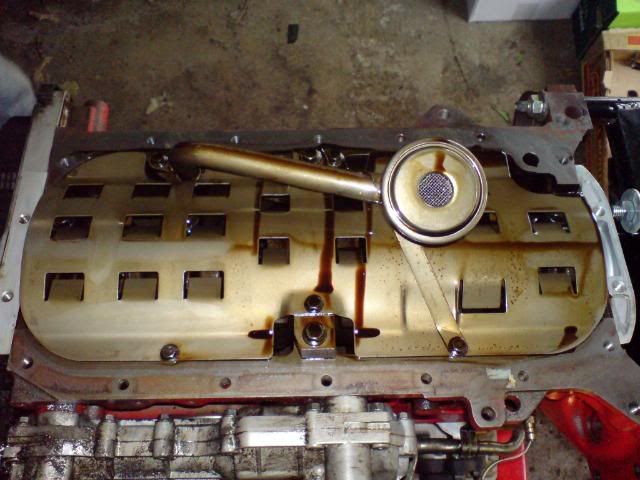
Wiring
Ecu:
0 280 000 950 - LH 2.4.2, the latest one, found on 1993-1994 960 B204FT
0 280 000 597 - LH 2.4.1,
found on 1991 960 wagon B204FT
0 280 000 578 - LH 2.4.1
1991 740, B204GT
LH 2.4
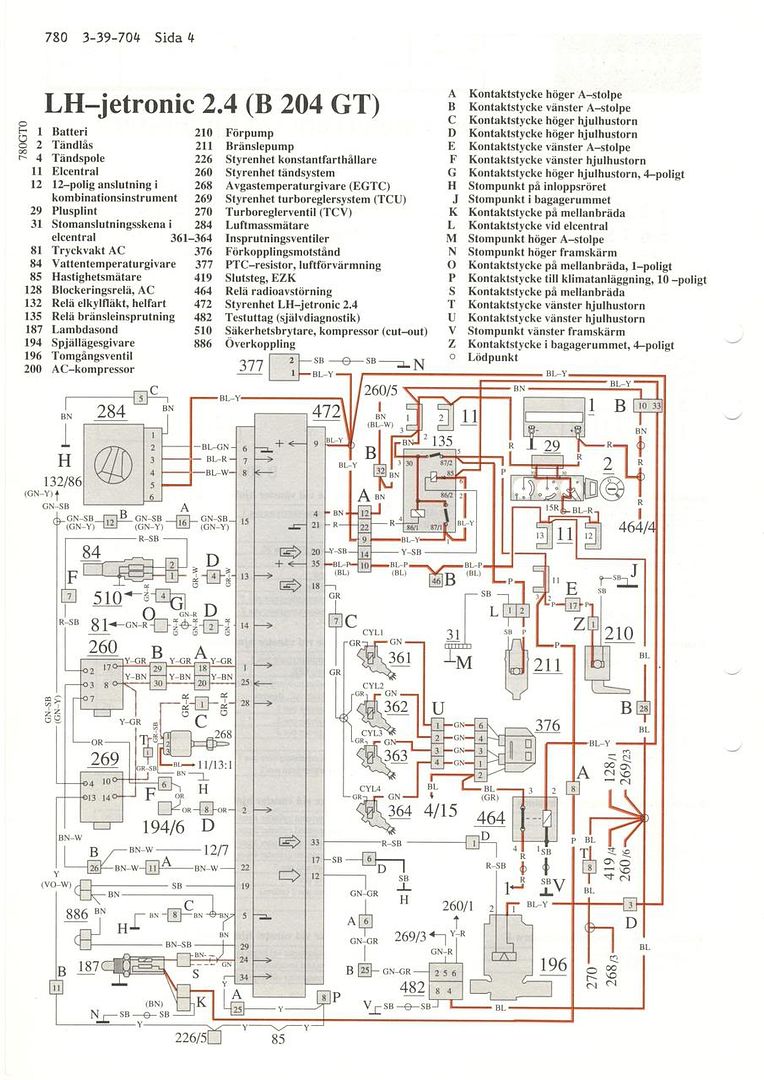
TCU
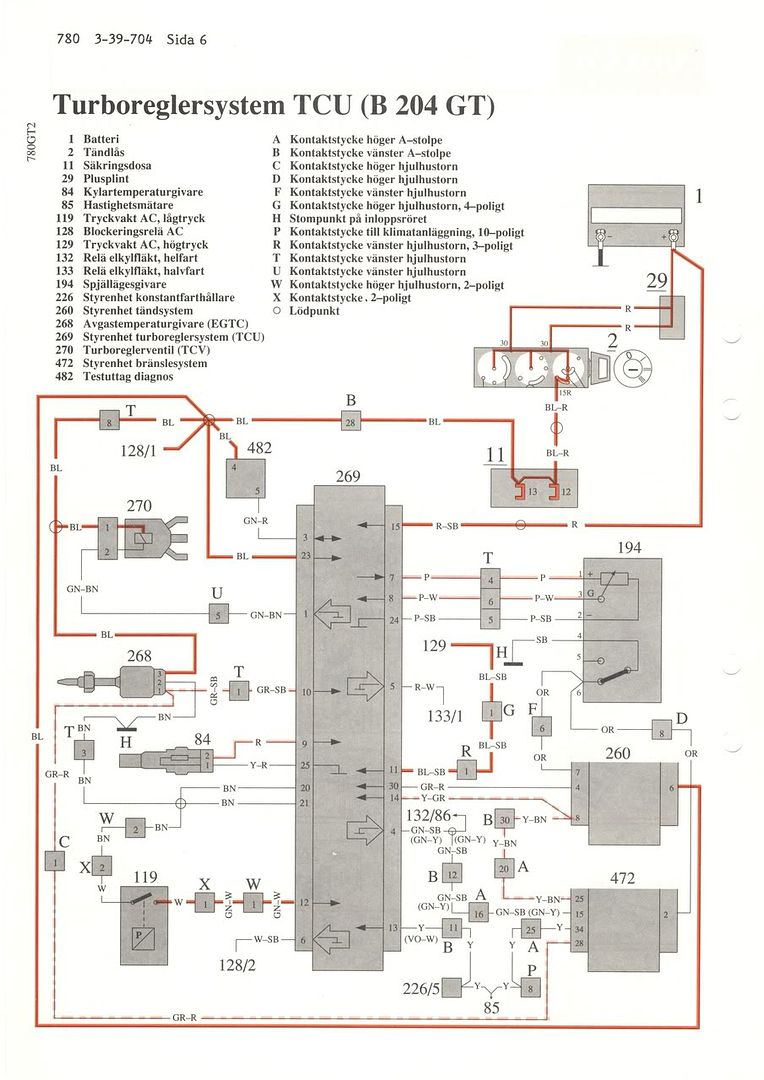
EZK
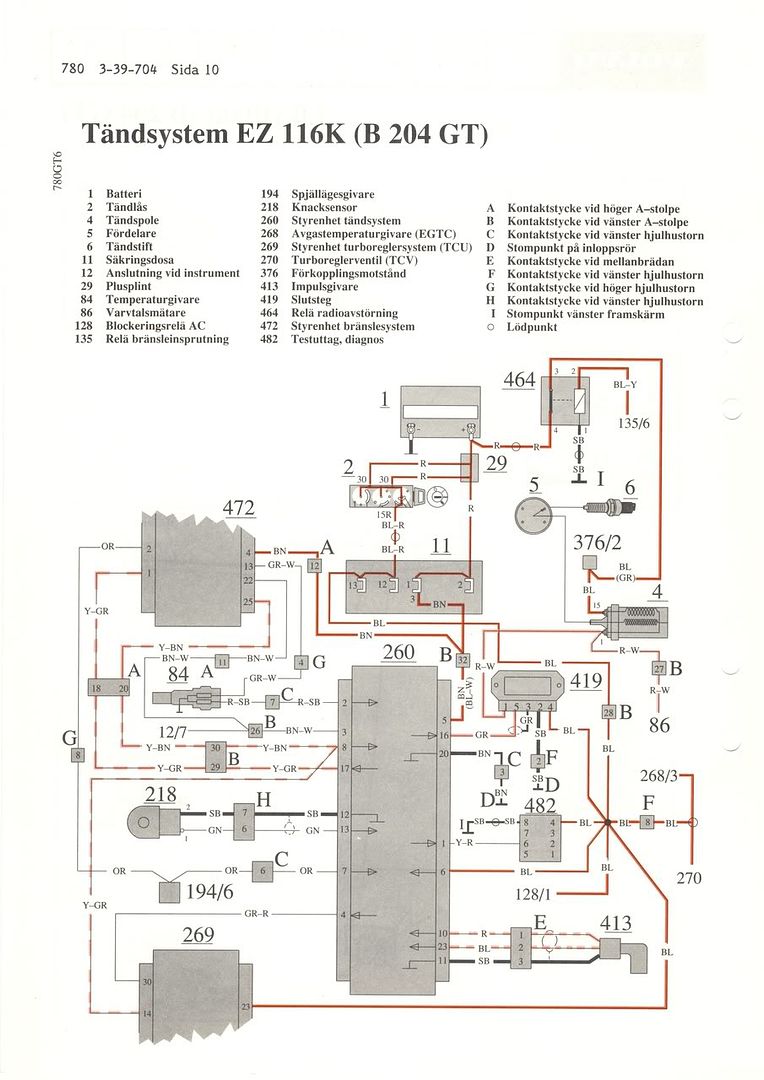
E-fan
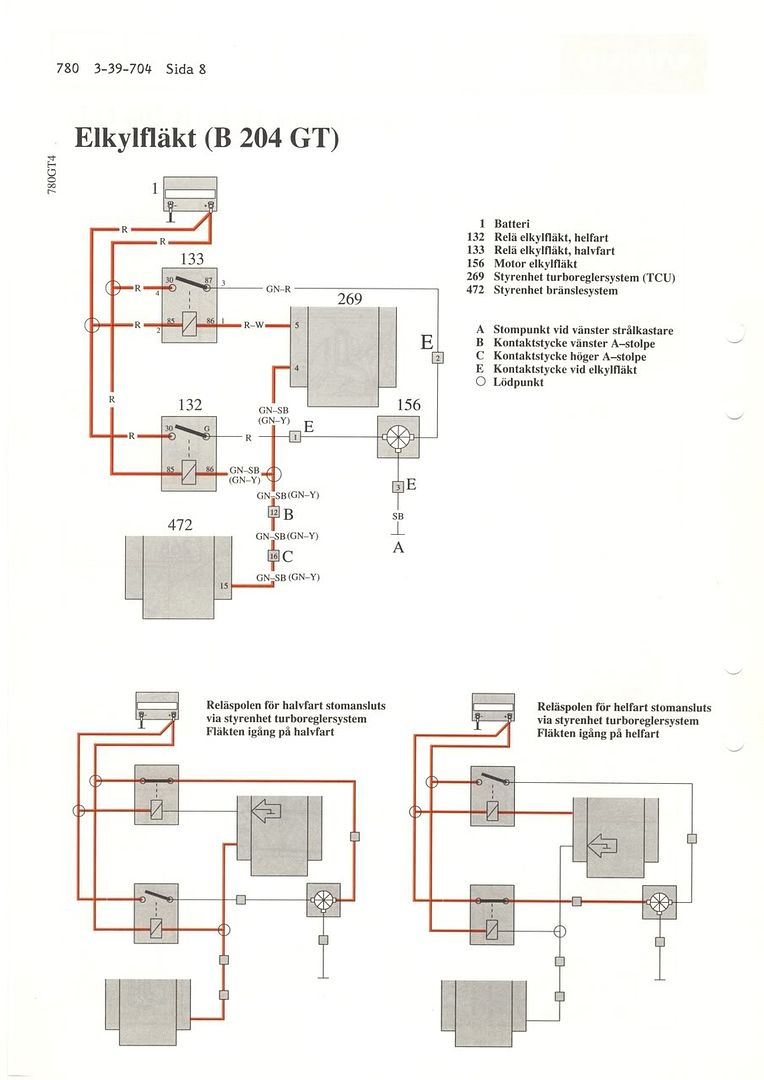
Pictures will be resized etc. Lots of information is from Vadis and needs some retyping...
The B204GT/FT:

These engines were designed for a few European countries where the 2.0L displacement had an advantage for roadtax. These engines were available in Belgium, France, Italy [and Portugal, Spain and...?]
Overview picture:

You can see a few things that are different:
- AMM (012). Also the plastic piping from airbox to AMM has a bigger radius
- Different intake and exhaust manifold
- Engine mount is also used for oil filter location
- Garrett T3 with internal CBV
History:
Here you see a press-release that never got to the press
It shows the basic info on the engine, but a preliminary amount of bhp and torque.
1

2

3

4

The B204GT was produced in 1989 and 1990 for the 740 and 780(as well?)
The B204FT was produced for the 960 up to 1994
The engine:
Basic info

Engines B204 FT/GT are two four cylinder 16-valve turbocharged engines of 2.0 liters cylinder capacity.
There is no difference in appearance between the two engines.
The difference between the FT and GT engines is that the GT does not have a three-way catalytic converter and has a lead resistant heated oxygen sensor (HO2S) so that it can be run on regular gasoline.
They were only produced with the M46. So no automatic or M90 (didn't exist up to '95)
Performance
B204GT:
- 200bhp @ 5300 rpm
- 290Nm (214 lbft) @ 2950 rpm
- acceleration 0-100 km/h (0-62 mph) = 7,9 seconds (740)
- top speed 215 km/h (136 mph)


B204GT
B204FT:
- 190bhp @ 5300 rpm
- 280Nm (207 lbft) @ 2950 rpm
- acceleration 0-100 km/h (0-62mph) (in 960) = ????? seconds
- top speed ???
See the right graph above
CR = 8,2:1
Weight (with TC) = +/- 165kg
Valves

The cylinder head is built in the same way as Volvos other 16 valve engines the exception being certain differences in the camshafts and valves.
The camshafts have modified cam profiles with lower lift height and faster opening/closing. The valvesprings are slightly stiffer in order to follow the cam profiles.
The new cam shaft profiles give a high low rev torque combined with free revving.
The valves have the same dimensions as the B 204 E, but the exhaust valves are sodium filled for better cooling.

The valves are operated by twin overhead camshafts through hydraulic tappets. The oil-filled tappets are self-adjusting.
The valve guides are inclined at an angle of 19? to the vertical.
Valve springs are 26.5mm in diameter
LengthAAAALoad (N)
46.6AAAAAA0
37.0AAAAAA330-370
29.5AAAAAA665-735
Inlet valve = 32.50 mm
Exhaust valve = 29.50 mm
Camshafts
The B204GT and B204FT are fitted with the FI (inlet) and FA (exhaust) camshafts.
Max. lift FI: 6.81mm (valves to open @ 12.9? after top dead centre)
Max. lift FA: 7.45mm (valves to open @ 31.2? before bottom dead centre
Combustion chamber
The 'pent-roof' combustion chamber features squish zones which force the fuel/air mixture towards the centre of the chamber as the piston approaches top dead centre (TDC) on the compression stroke - a feature which promotes excellent mixing as the fuel approaches the spark plug. The resultant short combustion path promotes rapid combustion, reducing the risk of self-ignition (or knock) and enabling a high compression ratio to be used. This, in turn, yields high performance at low fuel consumption.

Turbocharger and exhaust manifold
The exhaust manifold together with the turbo gives the advantage that a larger amount of the exhaust motion and heat energies can be used to drive the turbine and the compressor.
The exhaust manifold is designed to give maximum emission speed and equal exhaust back pressure in all cylinders which means that the exhaust energy can be used in a more effective way.
The turbocharger (TC) has a integral by-pass valve which damps the pressure rises which occur as a result of the throttle shutting quickly, which can otherwise disturb the mass air flow (MAF) sensor and cause problems with driveability.

The more air that is carried to the engine the more fuel that be burned and thus the engine gives better performance.

The stock turbocharger is a Garrett T3
Hot side: .48AR
Cold side: .42 AR (55 trim wheel) with internal CBV


Oil
To satisfy the high turbo engine specifications, due to the high load and temperature, the following changes have been made compared to the other 16 valve engines.
1.The oil pump capacity has been increased by 20% by a wider pump wheel and a modified profile.
2.The relief valve has a stiffer spring and opens at 5 bar pressure.
3.The engine is equipped with piston cooling openings to cool the pistons.
4.The oil cooler ensures that the oil does become overheated with high loading.

Fuel System
TCU
The B204FT/GT engine is equipped with an electronically controlled turbocharger (TC) control system to give optimum boost pressure and thus engine power under all varying circumstances.
By varying the boost pressure electronically, the turbocharger (TC) gives full power from 2300 (I think this is incorrect, more like 3500) rpm which in turn gives high torque through the whole engine speed range.
To provide maximum power with good bottom end torque, fast response and low fuel consumption, the B 204FT engine is equipped with a control system which is regulated by a TCU (Turbo Control Unit).
The control module controls the turbocharger (TC) boost pressure, electric cooling fans and climate control AC compressor.
-1. Boost pressure control (BPC) valve.
-2. Throttle position (TP) sensor.
-3. Pressure regulator.
-4. Turbocharger (TC) control valve.
-5. Manifold absolute pressure (MAP) sensor.

The control module receives information about the:
-Current turbocharger (TC) boost pressure from a manifold absolute pressure (MAP) sensor mounted in the control module.
-Engine speed (RPM) signal from fuel injection system control module.
-Information on the engine coolant temperature (ECT) from the temperature sensor mounted in the radiator.
-Throttle opening angle from throttle position (TP) sensor.
-Knock signal from the ignition system control module.
-Signal from speedometer.
-Signal from air conditioning (A/C) system pressure switches.
The control module carries out:
-Grounds the turbocharger (TC) control valve to control boost pressure.
-Lowers the boost pressure after maximum ignition retardation at ignition knock.
-Controls engine cooling fan (FC).
-Sends a signal to the LH-control module about idle air trim when the engine cooling fan (FC) runs at high-speed when the engine is idling.
-Disconnects the air conditioning (A/C) compressor when there is a high load on the engine.
-Is connected to the onboard diagnostic system and sends a signal if a fault occurs in the functions.
-Goes into an emergency program if certain signals are faulty or missing. The signals are given a programmed value so that the car can be driven to the workshop at a low speed.

If ignition knock should occur the ignition is retarded individually for each cylinder until the knocking stops.
If the engine continues to knock despite the ignition being maximally retarded on each cylinder, the ignition system control module sends a signal to the turbocharger (TC) control module which then lowers boost pressure in stages.
The value of the boost pressure being lowered depends on when the knock occurs. This still gives lower fuel consumption than the previous system, when the fuel enrichment was corrected when the ignition was retarded maximally.
The turbocharger (TC) control valve is a three way solenoid valve which is used to control the turbocharger (TC) boost pressure exactly and so eliminate “turbo lag”.
When the solenoid valve is not operating the terminal to the turbocharger (TC) intake side is closed while the terminals between the turbocharger (TC) pressure side and pressure regulator are open. Only the turbocharger (TC) boost pressure affects the pressure regulator which then functions as a normal mechanical system for boost pressure control, which gives a relatively low boost pressure, maximum 40 kPa.
The turbocharger (TC) control system control module receives the signal from the throttle position (TP) sensor, engine speed (RPM) signal from LH 2.4–control module and determines a desired value for the turbocharger (TC) boost pressure. This desired value is changed to a control signal to the turbocharger (TC) control valve which opens. The terminals to the turbocharger (TC) intake side are connected to the turbocharger (TC) pressure side and pressure regulator for a limited time, which gives a reference pressure to the pressure regulator.
The control signal gives a fast pulsing square wave signal with a frequency of 32 Hz. The solenoid valve opens and shuts once per period. This gives a mixture of atmospheric pressure and boost pressure in the pressure regulator, which because of its sluggishness will assume a position which is proportional to the solenoid valve opening and closing times.
The control pressure depends on the relationship between the time that the valve is open or closed during a period.
Because the control pressure is a mixture of turbocharger (TC) boost pressure and atmospheric pressure the boost pressure can increase to a value that exceeds the value that the pressure regulator would usually regulate. Maximum turbocharger (TC) boost pressure is 80 kPa above atmospheric pressure. A high boost pressure is retained even at fast throttle opening despite low engine speed (RPM), which gives fast response and eliminates “turbo lag”.
TCU unit:

Close-up:

EGTC
To avoid excessively high exhaust gas temperatures and reduce fuel consumption a special temperature sensor called an EGTC (Exhaust Gas Temperature Controller) is used. The EGTC sensor consists of a thermo element mounted in the exhaust manifold in front of the turbocharger (TC). It senses the exhaust temperature and generates a signal which is amplified in an electronic circuit mounted on the reverse of the engine. The amplified temperature signal is sent further to the fuel injection system control module, which gradually extends the injection period exhaust when the temperature reaches a critical level (approximately 950?C).
This contributes to a lower combustion temperature which in turn reduces the exhaust gas temperature, after which the increased fuel supply stops when the exhaust gas temperature has reached a normal level.
High exhaust gas temperatures occur for example at high power takeup over a long period of time, when driving in a hot climate or when driving with low octane fuel.


Inside the exhaust manifold
Mechanical:
The B204FT/GT engine has forged pistons, combined with the normal connection rods (13mm).
The pistons have valve reliefs cut in to them.

The engines are also equipped with a windage tray and block reinforcements (N/A 16V has the reinforcement as well, different p/n), see picture:

Wiring
Ecu:
0 280 000 950 - LH 2.4.2, the latest one, found on 1993-1994 960 B204FT
0 280 000 597 - LH 2.4.1,
found on 1991 960 wagon B204FT
0 280 000 578 - LH 2.4.1
1991 740, B204GT
LH 2.4

TCU

EZK

E-fan

Last edited:
